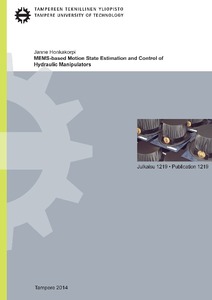MEMS-based motion state estimation and control of hydraulic manipulators
Honkakorpi, Janne (2014)
Honkakorpi, Janne
Tampere University of Technology
2014
Rakennetun ympäristön tiedekunta - Faculty of Built Environment
This publication is copyrighted. You may download, display and print it for Your own personal use. Commercial use is prohibited.
Julkaisun pysyvä osoite on
https://urn.fi/URN:ISBN:978-952-15-3327-3
https://urn.fi/URN:ISBN:978-952-15-3327-3
Tiivistelmä
This thesis considers the application of low-cost micro-electro-mechanical system (MEMS) inertial sensors to the motion state estimation and closed-loop motion control of heavy-duty hydraulic manipulators used in mobile machines. Currently, the sensor solutions potentially suitable for advanced robotic motion control, condition monitoring, and fault diagnostics systems suffer from poor performance and limited availability. This has hindered the ability of Finnish mobile machine manufacturers to differentiate themselves with innovative products and features on the increasingly competitive global market. Inertial sensors based on MEMS technology offer an attractive alternative to existing sensing solutions due to their low cost, low power requirements, small size, and straightforward surface installation capability. Although this technology has been widely available for some time now, MEMS inertial sensors have yet to be successfully applied on mobile machine manipulators on a larger scale, because the proper motion state estimation models and required signal processing methods are not generally known or well understood. The various error sources of the individual inertial measurements and the effects of accelerative motions are major contributing factors prohibiting the direct use of the sensor readings for feedback in a robotic motion control system, for example. Thus, the motivation for this thesis has been to develop a novel hydraulic manipulator motion state estimation approach based on low-cost MEMS inertial sensors, which can be applied on a large scale to existing mobile machines, and to provide the necessary real-time measurements for the aforementioned systems.
At its core, the motion state estimation approach proposed in this thesis is based on well-known rigid body motion kinematics, which are used to derive recursive forward kinematics of a generic serial link manipulator. The manipulator forward kinematics are coupled with complementary filtering, which is a powerful signal processing method ideally suited for the fusion of relatively low-resolution inertial measurements. This forms the theoretical basis for producing low-delay, low-noise smoothed estimates of the manipulator motion states with MEMS inertial sensors. The proposed motion state estimation model is experimentally verified on a small-scale test bench, after which it is evaluated as an integral part of the closed-loop motion control system on a full-size heavy-duty hydraulic manipulator. Comparative results are obtained using very accurate, high-resolution, and high-cost incremental encoders as reference sensors on the manipulator joints.
This thesis shows that by combining rigid body motion kinematics with an understanding of efficient yet straightforward signal processing methods, even low-cost and relatively low-resolution components can be used to create an innovative solution for hydraulic manipulator motion state sensing. This is a clear advantage over traditional sensor solutions, which are typically difficult to install, prone to failure, and incur high design and manufacturing costs. The novel technology developed in this thesis is expected to provide Finnish mobile machine manufacturers a substantial operational advantage in after-sales services and maintenance markets.
At its core, the motion state estimation approach proposed in this thesis is based on well-known rigid body motion kinematics, which are used to derive recursive forward kinematics of a generic serial link manipulator. The manipulator forward kinematics are coupled with complementary filtering, which is a powerful signal processing method ideally suited for the fusion of relatively low-resolution inertial measurements. This forms the theoretical basis for producing low-delay, low-noise smoothed estimates of the manipulator motion states with MEMS inertial sensors. The proposed motion state estimation model is experimentally verified on a small-scale test bench, after which it is evaluated as an integral part of the closed-loop motion control system on a full-size heavy-duty hydraulic manipulator. Comparative results are obtained using very accurate, high-resolution, and high-cost incremental encoders as reference sensors on the manipulator joints.
This thesis shows that by combining rigid body motion kinematics with an understanding of efficient yet straightforward signal processing methods, even low-cost and relatively low-resolution components can be used to create an innovative solution for hydraulic manipulator motion state sensing. This is a clear advantage over traditional sensor solutions, which are typically difficult to install, prone to failure, and incur high design and manufacturing costs. The novel technology developed in this thesis is expected to provide Finnish mobile machine manufacturers a substantial operational advantage in after-sales services and maintenance markets.
Kokoelmat
- Väitöskirjat [4764]
